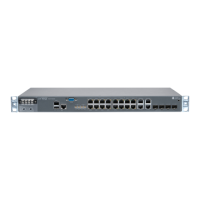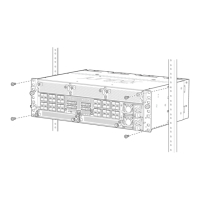•
Understanding Root Protection for Spanning-Tree Instance Interfaces in a Layer 2
Switched Network on page 429
•
Root Protect for a Spanning-Tree Instance Interface on page 430
•
Enabling Root Protection for a Spanning-Tree Instance Interface on page 430
•
LLDP Overview on page 431
•
Configuring LLDP in ACX Series on page 432
•
LLDP Operational Mode Commands on page 434
Layer 2 Control Protocol on ACX Series Routers
On ACX Series routers in a Layer 2 environment, you can configure various spanning-tree
protocol versions to create a loop-free topology in Layer 2 networks.
A spanning-tree protocol is a Layer 2 control protocol (L2CP) that calculates the best
path through a switched network containing redundant paths. A spanning-tree protocol
uses bridge protocol data unit (BPDU) data frames to exchange information with other
switches. A spanning-tree protocol uses the information provided by the BPDUs to elect
a root bridge, identify root ports for each switch, identify designated ports for each physical
LAN segment, and prune specific redundant links to create a loop-free tree topology.
The resulting tree topology provides a single active Layer 2 data path between any two
end stations.
NOTE: In discussions of spanning-tree protocols, the terms bridge and switch
are often used interchangeably.
The ACX Series Universal Access Routers support Spanning-Tree Protocol (STP), Rapid
Spanning-Tree Protocol (RSTP), Multiple Spanning-Tree Protocol (MSTP), and VLAN
Spanning-Tree Protocol (VSTP).
•
The original STP is defined in the IEEE 802.1D 1998 specification. A newer version called
RSTP was originally defined in the IEEE 802.1w draft specification and later incorporated
into the IEEE 802.1D-2004 specification. A recent version called MSTP was originally
defined in the IEEE 802.1s draft specification and later incorporated into the
IEEE 802.1Q-2003 specification. The VSTP is compatible with the Per-VLAN Spanning
Tree Plus (PVST+) and Rapid-PVST+ protocols supported on Cisco Systems routers
and switches.
•
RSTP provides faster reconvergence time than the original STP by identifying certain
links as point to point and by using protocol handshake messages rather than fixed
timeouts. When a point-to-point link fails, the alternate link can transition to the
forwarding state without waiting for any protocol timers to expire.
•
MSTP provides the capability to logically divide a Layer 2 network into regions. Every
region has a unique identifier and can contain multiple instances of spanning trees. All
regions are bound together using a Common Instance Spanning Tree (CIST), which is
responsible for creating a loop-free topology across regions, whereas the Multiple
Copyright © 2017, Juniper Networks, Inc.404
ACX Series Universal Access Router Configuration Guide

